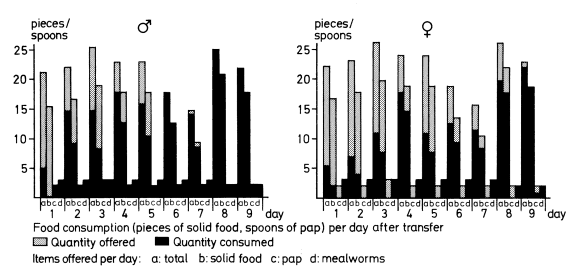

When disturbed by some stimulus or
frightened,
slender lorises usually show slow, hesitating movements, often
freezing
to motionlessness for a limited time (a). Hiding of the
conspicuously
coloured face (b), hiding behind some cover (c) or
flight
to a high place (d) are also common signs of environmental
stress
due to some disturbance. When closely approached, the animal may
try to
defend itself by growling (d), other threat behaviour or
attacks.
e:
Hanging under the ceiling for a longer period after disturbance
indicates
rather severe stress; the animal may even sleep in this position (f).
g:
longer freezing in unusual, asymmetric postures has been observed
in animals
suffering from severe stress after transport to an unfamiliar
environment;
in such cases, protection from noise and other disturbance is very
necessary.
h:
Particularly in animals suffering from environmental stress,
acoustic stimuli
or sudden changes of light intensity may cause epileptoform
seizures with
saliva dripping from the mouth.

Reduced food consumption is another typical consequence of severe
environmental
stress. The figure above shows the amount of food consumed in the
first
days after transfer to a new environment by two animals.
Quarantain conditions
were good in this case, with protection from optical and
acoustical disturbance
and plenty of cover in the cages.
Privacy policy / Datenschutz
|
Loris
and related species: health
|
Last
amendment: 5 May 2000
|